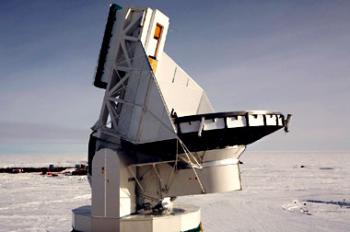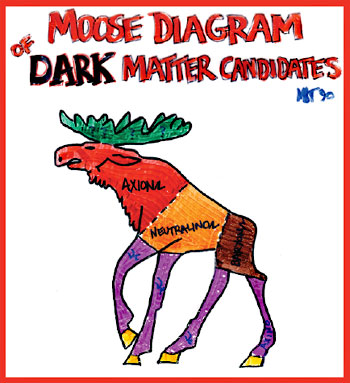 |
 |
 |
 |
 |
 |
 |
 |
 |
 |
|
KICP Workshops & Events
|
KICP Lectures, Talks, & Events, 2008 South Pole Telescope Exploratorium Web cast December 7, 2007 - January 18, 2008 | 10:00 AM  Dec 21, 2007: Join us as we talk with scientists working on the South Pole Telescope. In today's program, we'll learn about the various projects and teams of people on the project, how they work together, and how they analyze the data they receive. Jan 18, 2008: In our final talk with the South Pole Telescope staff, we'll learn about data collection. We'll focus on the receiver, a very precise instrument that is a sensitive, state-of-the-art data collector with a thousand "eyes" pointed to the distant universe. We'll also meet the scientists who will be wintering over at the South Pole for eight cold, dark months. Related Links: KICP Members: John E. Carlstrom Scientific projects: South Pole Telescope (SPT) Josh Frieman, Mapping the Heavens: "The Universe Revealed by the Sloan Digital Sky Survey" January 12, 2008 | 4:30 PM | Adler Planetarium & Astronomy Museum In this full-dome multimedia presentation, Dr. Frieman will describe and fly us through the Sloan Digital Sky Survey (SDSS), the most ambitious 3D map of the Universe ever constructed. This flight will let us explore this vast survey that is shaping our understanding of how the Universe has evolved from its earliest moments. Related Links: KICP Members: Joshua A. Frieman Scientific projects: Sloan Digital Sky Survey (SDSS) Randall Landsberg, "Catching Cosmic Monsters: Powerful & Rare" March 27, 2008 | 2:00 PM | Boston Convention & Exhibition Center, Room 259B Website From brains to the Big Bang, take a crash course in forefront science with the NSF Physics Frontier Centers, including hands-on activities and summer opportunities. Read more >> Related Links: KICP Members: Randall H. Landsberg KICP open house for prospective graduate students April 4, 2008 | 1:00 PM | LASR Conference Room 152 1:00 - 1:30 PM Reception for Astronomy & Physics students with KICP faculty, fellows and students 1:30 - 2:00 PM Presentations by Stephan Meyer and Andrey Kravtsov 2:00 - 3:00 PM Lab Tours or Theory Group: * Collar lab tour (Juan Collar) * CMB lab tour (Clarence Chang, Tom Crawford, Jeff McMahon) * meet with individual members of theory group 67th Compton Lectures: Kathryn Schaffer, "Seeing and Believing: Detection, Measurement, and Inference in Experimental Physics" April 5 - June 14, 2008 | 11:00 AM | Kersten Physics Teaching Center Website | Online Materials Physics today pushes ahead with new results and ideas that can sound fantastical and bizarre. How can we possibly stand in a lecture hall in Chicago and talk sensibly about the beginning of the universe, or phenomena at impossibly small scales? Anyone, faced with the notions that arise at the frontiers of physics, has the right to ask: "How can you know that?", and "Why should I believe it"? While physics involves some speculation, the major results in the field are always based on concrete observations and down-to-earth reasoning. Most experimental results in physics can be boiled down to detection of a radiation signal, measurement of properties of that signal, and inference using statistics and cross-checks. Therefore, an understanding of the physics of detection and simple statistics can go a long way towards demystifying even the strangest claims in the field. The 67th Compton Lecture Series will tackle the buzzing subatomic world and the physics of radiation detection, using case studies from neutrino physics and cosmology to explore measurement and uncertainty on some of the frontiers of the field. Read more >> Related Links: KICP Members: Kathryn K. Schaffer Postal Service pays tribute to astronomer Edwin Hubble April 30, 2008 | 3:00 PM | Research Institutes building, Room 480 Chicago unveiling of commemorative stamp honoring University of Chicago alumnus Edwin Hubble. The event is open to the public. Edward "Rocky" Kolb, Professor and Chairman, Department of Astronomy and Astrophysics, University of Chicago James Mruk, Manager, Public Affairs & Communications, Great Lakes Area of the United States Postal Service In March, the U.S. Postal Service acknowledged some of the most impressive scientific achievements of the 20th century with the issue of its second series of American Scientists stamps. Astronomer Edwin Hubble (1889-1953), alumnus of the University of Chicago (S.B., 1910, Ph.D., 1917), played a pivotal role in deciphering the vast and complex nature of the universe. His meticulous studies of spiral nebulae proved the existence of galaxies other than our own Milky Way, paving the way for a revolutionary new understanding that the cosmos contains myriad separate galaxies or "island universes." The local unveiling of the Edwin Hubble stamp will take place before the weekly colloquium of the University's Department of Astronomy and Astrophysics. Related Links: KICP Members: Edward W. Kolb Cafe Scientifique: Michael S. Turner, "The Dark Side: from Dark Energy and Dark Matter to Washington and Science Policy" June 16, 2008 | 7:00 PM | Map Room, 1949 North Hoyne Ave Chicago, IL  Cosmology is in a golden age of discovery and understanding. Using telescopes, underground detectors and accelerators, cosmologists are poised to answer big questions --- what is the dark matter that holds our galaxy and every structure in the Universe together? What is the nature of the dark energy that is causing the expansion of the Universe to speed up? And What happened before the big bang? This exciting research is largely funded by the federal government in a way that is more complicated than rocket science, but which has broad support from the public. Related Links: KICP Members: Michael S. Turner Cafe Scientifique: Juan Collar, "Searching for Cosmic Dark Matter in the Sewers of Chicago" September 15, 2008 | 7:00 PM | Map Room, 1949 North Hoyne Ave Chicago, IL Online Materials (PDF) The quest for a solution to the deepest cosmological mysteries (e.g., What is Dark Matter?) calls for extreme measures. Juan Collar, an ordained particle hunter, will share some of the tricks of his trade with anyone willing to listen. This conversation will range from the sophisticated detector technologies developed to catch particles that may or may not be there, to the exotic venues (including sewers, mines thousands of feet deep, and the crawl space under a nuclear reactor), to the sheer quiet desperation of it all. Related Links: KICP Members: Juan I. Collar Scientific projects: COUPP/PICO 68th Compton Lectures: Brian Humensky, "Stars: Their Life and Afterlife" October 4 - December 13, 2008 | 11:00 AM | Kersten Physics Teaching Center One star explodes and thousands of years later we observe its remains as a beautiful shell of matter shining across the observable spectrum. Another star explodes and leaves behind a rapidly spinning neutron star, powering a nebula of hot gas. A third ends in a black hole, visible only by inference from the hot matter surrounding it. What physical processes give rise to these amazing explosions and beautiful remnants? What determines how a star evolves and how it ends its life? What role does a star’s environment play – and how does a star influence its environment and affect its neighbors? In their death throes and after, stars are responsible for a lot more radiation than just your basic starlight: radio, X-rays, cosmic rays, gravity waves, gamma rays, pulsed light. How do they do that? The 68th Compton Lecture Series will take a look at how stellar formation and evolution connect with the exciting, often quite energetic, ways in which stars die and will examine the fascinating remnants and radiations they leave behind. Related Links: KICP Members: Brian Humensky |





 Overview
Overview